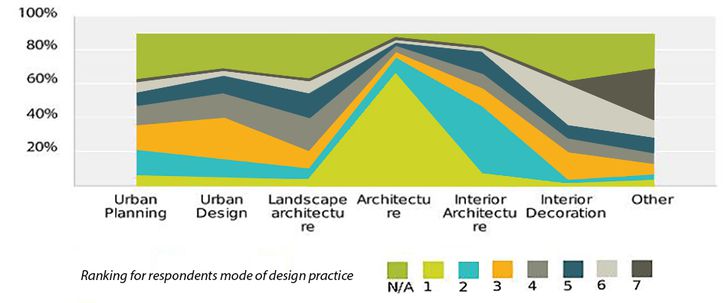As designers, how do we inform ourselves about the transactions that occur between people and the spaces that they occupy? Do we rely on personal knowledge, gained through subjective observation, or do we gather data from other sources? Do we use the new digital tools that are now available to gather the intelligence we need for design practice?
In this post-digital age, demand is growing for an evidence-based approach to the design of cultural, corporate and institutional spaces that will not only contain but also support the specific activities of their occupants.1234 These kind of ‘performative environments’ are publicly accessible, socially and culturally complex places that have a direct impact on human experiences and events. To design such environments, we require detailed knowledge of anthropospatial5 behaviour and experience, beyond the scope of any one designer’s personal experience.
In this article, we present the results of a global pilot study undertaken in 2013 that sought some early answers to those opening questions.6 The results of this study provide an interesting glimpse into the knowledge practices of design professionals around the world. Although we as designers recognise the need to inform ourselves about the people we design for, it appears that we generally do not access explicit information, beyond our own experience or that of our clients. Most of us do not refer to research literature, nor do we engage in post-occupancy analysis of completed projects. The primary reasons given were a lack of time and/or the financial resources to do so, but there is also something deep in the culture of design that gets in our way – our training.

Global locations for survey respondents.
Image: Evidence Based Design Journal
To gain insight into the knowledge practices of designers, this study had two primary research questions: first, to what extent do we refer to research literature from other, relevant disciplines and, second, to what extent do we gather empirical, post-occupancy data about the ways in which people experience completed projects. The first aim was to identify the extent to which architectural practices rely on tacit or personal knowledge and/or the extent to which they augment that knowledge through post-occupancy analysis and the literature of related fields outside of architecture—particularly the fields of sociology, anthropology and psychology.
Our second aim was to identify whether a practice involved in the design of performative environments is more likely to engage in an evidence-based design process. In other words, if your practice is primarily designs urban, learning or work environments, are you more likely to gather explicit data than a practice that is mostly engaged in, say, bespoke residential design?

Modes of practice for survey respondents.
Image: Evidence Based Design Journal
Although 80% of respondents perceived a need for explicit data gathering, 68% of respondents never, or only occasionally, review anthropospatial research literature. In Australia and New Zealand, this percentage climbs to 88% and in South America it is reduced to 59%. On average, just 16% of designers will review research literature as a matter of course, but in Australia that percentage drops to 5%.
71% of participants indicated that they never engage in post-occupancy analysis (POA) of completed projects. In Europe, this percentage increased to 76%. Just 6% of participants undertake a formal POA as a standard part of their practice. Subsequent research indicates that less than 1% do so with a degree of rigour and none of the respondents undertook more than one analysis on a completed project. In other words, they do not return, after an elapsed period of time, to confirm the results of the first study. Of those practices that undertook POA, 37% were self-funded by the design practices. 37% of all respondents also stated that the reason they do not undertake POA is because of a lack of demand or interest from clients. Where clients were amenable to the idea, they would not cover the cost of the study.
We also determined that even when performative environment projects represented more than 50% of a practice’s workload, the increase in explicit data gathering was only around 1% above the average.

Main results of global survey into knowledge practices of design studios.
Image: Evidence Based Design Journal
Conclusion
“Every object made by man is the embodiment of what is at once thinkable and possible … This interaction between what is thinkable and what is possible, which we refer to as design, is neither simple nor straightforward … The activities of creation and invention are expressed in the ability to relocate the bounds imposed in other systems of reference, thus creating the new, that which until now has not been thought of and indeed seemed unthinkable.”
—Ezio Manzini, 1986
If, as is beautifully suggested by Ezio Manzini, design innovation requires the shifting of an entire territory to embrace “other systems of reference”, then, by rights, we should be broadening our horizons by gathering as much data as is possibly available to us. And yet, our study indicates that most design practices do not seek to augment personal knowledge with reliable information from research literature or post-occupancy analysis, and this is a global phenomenon. To be fair, up until quite recently we had few effective tools to do so – but now we do.
Although the study indicates there is a perceived need for explicit data gathering, it appears it is not sufficiently valued by designers, or their clients, to be included as a costed service. Respondents provided explanations based on a paucity of time and money. However, we argue there are two primary causes: the first is our training and the second is the traditional idea that architectural space is fixed and therefore not evolving. After all, the need for post-occupancy analysis is limited if nothing can be changed. More deeply rooted is the problem of our training where, as Philip Thiel suggests, we are taught to develop a universal model for everyone,4 but without any external validation of that model. Design studios do not require us to gather ground-level intelligence about the potential impact of our ideas. We make design decisions about anthropospatial consequences on the basis of personal experience alone, and the potential truth of our assumptions is almost never tested. Importantly, we miss the opportunity to explore a world of ideas and potential experiences that are quite literally beyond us. Reasons are many and varied – and they will have to wait for another time, another article.
What is certain is that, in the face of continuing and rapid social change, our traditions must evolve. The tacit knowledge that has served us well for centuries will require augmentation. The question is: how to incorporate that knowledge into a design process that relies equally on thought and play?
This article was orginally published by Evidence Based Design Journal, a new resource for architects and designers who want to learn more about the ways in which people interact with the built environment. See www.ebdjournal.com for more.
1 Rosalyn Cama, Evidence-based Healthcare Design (New Jersey: John Wiley & Sons, 2009)
2 Roger S. Ulrich, Craig Zimring, Xuemei Zhu BArch, Jennifer DuBose, Hyun-Bo Seo, Young-Seon Choi, Xiaobo Quan, and Anjali Joseph, ‘A Review of Research Literature on Evidence-Based Healthcare Design’, Health Environments Research & Design Journal, 2008.
3 Francis Duffy & Les Hutton, Architectural Knowledge, The Idea of a Profession (London: Routledge, 1998).
4 Philip Thiel, People, Paths, and Purpose: Notations for a Participatory Envirotecture ( Washington: University of Washington Press, 1996) .
5 Broadly speaking, ‘anthropospatial’ is a word Evidence Based Design Journal has coined to describe the transaction between people and the built spaces that they occupy. The term ‘Proxemics’ is traditionally used in relation to person-to-person crowd behaviour, and can be expanded to understand the impact of the built environment, but it is not really adequate. Plus, we like the sound of anthropospatial.
6 Participants were sought though online resources such as LinkedIn and Archdaily and the final sample size was n=420. Respondents emerged from a variety of regional locations, with the largest representations emanating from the US (31%) and Europe (24%). 73% of participants identified architecture and 8% identified interior architecture as their primary mode of design practice. The disciplines of urban planning and urban design accounted for 10% of respondents, while landscape architecture represented just 4.5%. For the purpose of this study we focussed on urban, work, health, retail and learning environments.
















